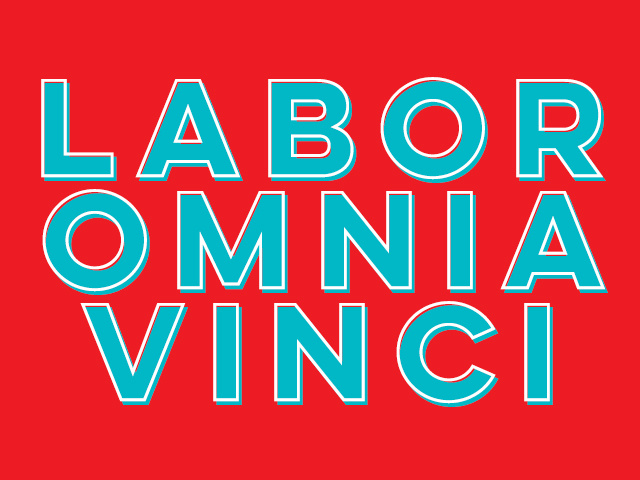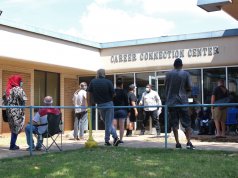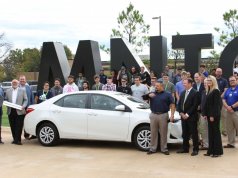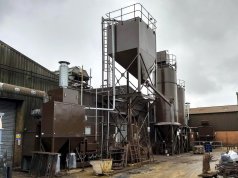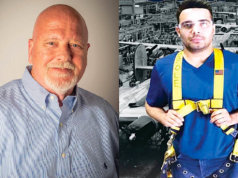
(Editor’s Note: NonDoc will look at various issues related to “labor” in Oklahoma and the nation this week following Labor Day. You can read the introduction to our series here.)
The state motto of Oklahoma is Labor Omnia Vincit, or “labor conquers all.”
But while the history of organized labor in Oklahoma is one of political strength, “labor issues” in Oklahoma mostly sit stagnated in a national and local political climate that is not particularly friendly to the labor movement’s causes. Furthermore, public confusion abounds regarding exactly who does what on labor regulation.
“You can look at the nationwide picture about income inequality,” said Oklahoma AFL-CIO president Jim Curry. “The rich are getting richer and the poor are getting poorer, and the middle class is sinking. It’s tied directly to union membership, and especially if you go back over decades and look at every state. The more union membership, the bigger the middle class was in that state.”
For the past 16 years, Oklahoma union membership rates have been slightly below the national average, according to U.S. Bureau of Labor Statistics.
“The more that union membership shrinks, the more the middle class is going to shrink,” Curry said. “Nobody can argue that point, as it’s borne right there in statistics in black and white.”
Union membership in Oklahoma — as defined by individuals in either a union or a similar employee association — decreased from 114,000 in 2013 to 89,000 in 2014, according to an economic news release from the U.S. Bureau of Labor.
When you include individuals who report no union affiliation — but whose jobs are, in fact, covered by a union or an employee association contract — those numbers climb to 144,000 in 2013, and 106,000 in 2014, the release noted.
In short, that means fewer people are choosing to be members of labor unions in Oklahoma, a fact that affects how unions allocate their representation resources as well as their political influence.
“After Right To Work passed in 2001, we lost membership,” Curry said. “Between that and, of course, 9/11 — which happened within a few weeks of one another — we lost tens of thousands of members. We’ve now dropped down to 100,000 to 110,000, in there. And it varies from year to year.”
Curry said the Oklahoma chapter of the American Federation of Labor and Congress of Industrial Organizations represents more than 220 local unions from three main sectors: building and trade workers, public sector workers (such as government employees, police, firefighters, and flight controllers) and private sector workers that come from mostly industrial companies.
“Personally, the draw for me to go to organized labor and unions (is) you get treated with dignity and respect on the job,” Curry said. “There’s a set of rules that both the employee and the employer have to abide by, and if you’ve got a disagreement, you get a third party that will listen to both cases and render a decision. It’s just a fair democracy in the workplace that gives workers a voice on the job, and they cannot be dismissed on a whim.”
The Department of Labor
Oklahoma is one of four states that elects its Commissioner of Labor by popular vote, and the post is currently awaiting gubernatorial appointment in the wake of Commissioner Mark Costello’s tragic death.
While the position has often been held by labor-union-endorsed candidates, Costello initially clashed with unions upon taking office in 2011, with labor leaders calling for his resignation owing to policy changes he was promoting. The commissioner, however, became known as someone willing to work through differences, his staff said.
“We have a great relationship with the unions,” said department communication director Liz McNeill. “It’s a testament to [Commissioner Mark Costello’s] charisma and natural abilities that, after we had an awkward situation with the AFL-CIO when the commissioner first came in — and after they got to know each other — we haven’t had an incident since.”
But that relationship with unions is one that may exist more in the public’s perception than in reality. While it would make sense to think organized labor unions work closely with — or are regulated by — the Oklahoma Department of Labor, labor leaders say that is not particularly the case.
“Commissioner Costello and myself had a very good professional relationship,” Curry said. “He was very polite, professional and, despite differences in policy, he loved spirited debate.”
But that does not mean organized labor and the department interact on a daily basis, even when they argued.
“The relationship between the Oklahoma AFL-CIO and the Oklahoma Department of Labor is the same as it has been for years,” Curry said. “Since the Courts overturned the Oklahoma Prevailing Wage Act, there is not a department in the OKDOL that has anything to do with regulating or overseeing anything to do with organized labor. Quite honestly (…) there is basically nothing that the OKDOL does that affects us.”
Public and private sectors
Public sector unions also feed into the AFL-CIO, which is one of the primary labor organizations in the state, but certainly not the only. The Oklahoma Education Association is the local chapter of the National Education Association, a major teachers’ union.
It was 1907 — Oklahoma statehood — when the Oklahoma Department of Labor was created after “delegates from the Twin-Territorial Federation of Labor, the State Farmers’ Union and the Railroad Brotherhoods met in Shawnee, Oklahoma, to formulate a list of demands for the upcoming constitutional convention,”according to the department’s website. “One demand called for the establishment of a State Labor Department.”
While the department’s mission is to “help ensure fairness, equity and safety in Oklahoma workplaces through ethical behavior, conscientious guidance and loyal service to Oklahoma’s employers and employees,” most of the regulations governing labor unions exist at the federal level.
Curry, Phil Sipe of the International Association of Firefighters Local 157 in Oklahoma City and other union leaders said their main concerns are with federal labor laws.
“The national AFL-CIO has been lobbying for years that we need to change our federal labor laws,” Curry said. “They were first enacted in 1935, and they have not been changed since.”
Curry said unions in states where employees are not required to pay union dues — so called Right To Work states — struggle with federal requirements to represent workers even when they are not dues-paying members. The 17,000-person gap between union members and employees working in unionized fields is representative of that issue.
Curry also said rights to collective bargaining are “slanted heavily in favor of an employer.”
Sipe joined Curry in saying the portrayal of unions as greedy, strike-happy organizations has negative consequences.
“This is something that I think is grossly unfair with the public perception of unions,” Sipe said. “We spend a lot of money on charitable activity, and so in terms of being a community partner, we do a lot of that kind of work. And somehow that’s lost on people. They say, ‘Oh the union is just wanting more money.’ But we have tons of programs in place.”
Sipe said media often paint public sector unions with the same brush as private sector unions, despite major differences between them, including their legal abilities and relative proclivities for going on strike.
“When I see some of the responses and read it in newspapers and magazines and online and on the Drudge Report, some of them, frankly, are just laughable because it proves how utterly uninformed and uneducated people are about what unions do,” Sipe said. “Some negative comments are justified, but I think, in most cases, they are not. Stop making generalizations, because that’s unfair to everybody.”
Curry, Sipe and members of the Department of Labor all agreed that public understanding of labor issues is limited.
“We have a great relationship with Unions, and working with an employer who has a unionized site,” said Diana Jones, a director for the OKDOL. “The union will invite us in to participate with the on-site [workplace safety] process.”
Department chief of staff Jim Marshall was unavailable for comment, according to McNeill.
Communication is key
In regard to potential conflicts between private management, labor unions and the OKDOL, Jones noted good communication is key.
“Management or the union will call us, but we all have the same goal of creating a safer work environment,” Jones said.
She added that, if a more serious issue is reported that could be a violation of Occupational Safety & Health Administration rules, the department will refer the case to the U.S. Department of Labor.
Jones said she handles a wide range of public health and OSHA regulations including those for city, county and state facilities, universities and public schools. The department also oversees asbestos abatement, amusement rides, pressure-vessel inspections and child labor laws.
McNeill and Jones said the department also oversees a voluntary program to bring Oklahoma workplaces in line with OSHA requirements, enabling significant reductions in worker’s compensation insurance premiums paid by businesses.
Curry said the public stays unfamiliar with many of the topics addressed by the department, unless a problem arises.
Likewise, he said the public has not been focused on the political issues his union likes to discuss.
“Unfortunately, our issues are not the issues that are driving the elections,” the long-time union boss said. “The issues that are driving the elections are like Ten Commandments on the Capitol grounds, abortion or gun rights. A lot of social issues. Not what we used to call ‘paycheck issues.’
“Maybe it’ll turn back around. But those issues haven’t been on the top of the radar like the social issues have been here lately. Usually when times get tough, it makes people pay more attention.”
(Correction: An earlier version of this story identified Jim Marshall’s title incorrectly.)
William W. Savage III contributed to this report.









